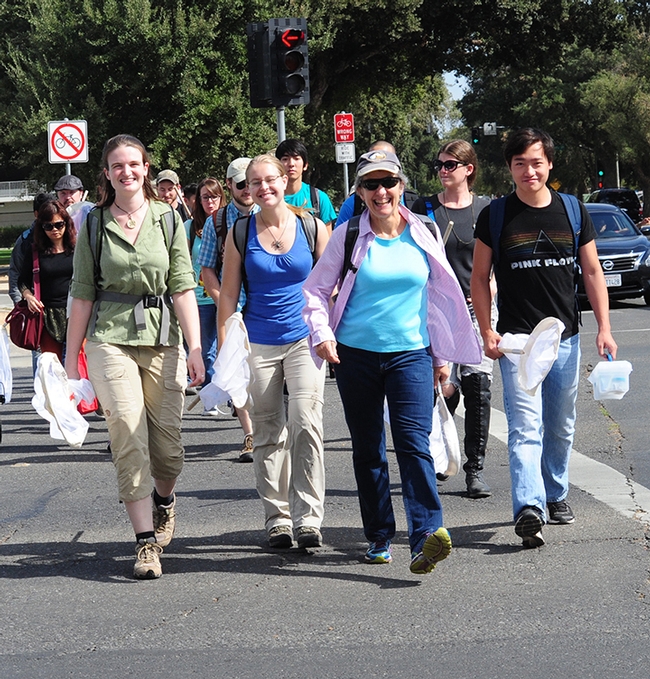- Author: Kathy Keatley Garvey
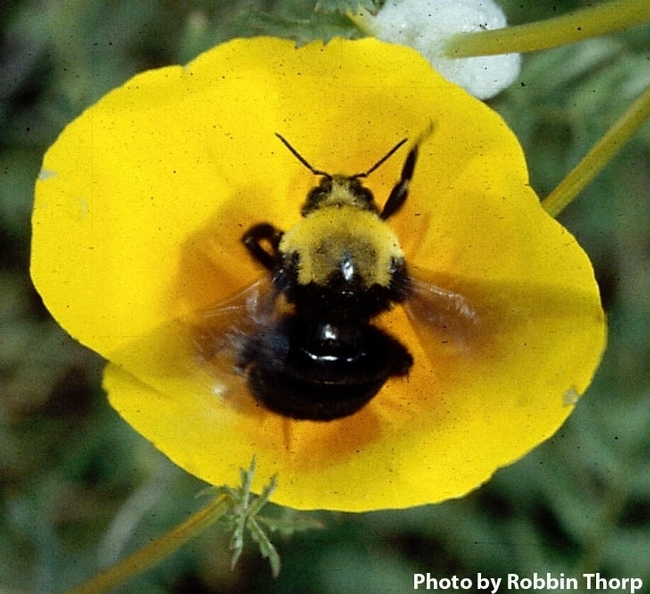
Professor Thorp (1933-2019), a 30-year member of the Department of Entomology and Nematology and a worldwide authority on bees, was a tireless advocate of bumble bee conservation. During his retirement, he co-authored Bumble Bees of North America: An Identification Guide (Princeton University, 2014) and California Bees and Blooms: A Guide for Gardeners and Naturalists (Heyday, 2014).
And every summer from 2002 to 2018, Thorp volunteered his time and expertise to teach at The Bee Course, an annual workshop sponsored by the American Museum of Natural History and held at the Southwestern Research Station, Portal, Ariz.
Thorp also served as the regional co-chair of the Wild Bee Specialist Group of the International Union for Conservation of Nature (IUCN) and sounded the alarm about bumble bee declines, including Franklin's bumble bee, Bombus franklini, found only in its narrow distribution range of southern Oregon and northern California. Thorp last saw it near Mt. Ashland in 2006 and it is is now feared extinct or at the brink of extinction. The bee inhabits--or did--a 13,300-square-mile area confined to five counties--Siskiyou and Trinity counties in California; and Jackson, Douglas and Josephine counties in Oregon.
Enter the California Bumble Bee Atlas (CBBA), a collaboration of the California Department of Fish and Wildlife (CDFW), Sacramento, and the Xerces Society for Invertebrate Conservation, headquartered in Portland, Ore. Launched in March 2022, the Atlas is a "collaborative community science effort to track and conserve the state's native bumble bee species," according to Dylan Winkler, bumble bee scientific aide for the CDFW's Wildlife Diversity Program.
Back in September 2021, the U.S. Fish and Wildlife Service announced that the American bumble bee, "whose populations have plummeted by nearly 90 percent, may warrant Endangered Species Act protection." The announcement kicked off a one-year status assessment of the species. (See news story)
If you're interested in bumble bee conservation, take note. Winkler will lead a "Bumble Bee Walk" from 10 a.m. to noon on Saturday, May 28 in the UC Davis Arboretum and Public Garden. The goal is to teach interested participants how to survey bumble bees. You can pre-register at https://arcg.is/0PDyO4. Organizers plan to cap attendance at 20 people. Details about this Atlas event and several more scheduled in June:
- Saturday, May 28: UC Davis Arboretum, Davis, CA (Yolo County), parking at Putah Creek Lodge Parking Lot, Garrod Drive, Davis, CA 95616. Tour of the native plant gardens and the forest along Putah Creek from 10 a.m. to noon.
- Saturday, June 4: The Gardens at Lake Merritt, 666 Bellevue Avenue, Oakland, CA (Alameda County). Tour of the gardens from 9 a.m. to 11 a.m.
- Sunday, June 5: College of Marin at Kentfield (Marin County), parking at covered Lots 6/7 off College Ave, Kentfield, CA 94904. Details: Meet at bridge over Corte Madera Creek. Tour of the campus native plants from 10 a.m. to noon.
- Saturday, June 18: Soil Born Farms, Rancho Cordova, CA (Sacramento County), parking at Soil Born Farms: American River Ranch, 2140 Chase Drive, Rancho Cordova, CA 95670. As part of National Pollinator Week, the group will tour the gardens from 10 a.m. to noon. Closed-toed shoes required.
Of the 50 species of bumble bees found in North America, an estimated 25 inhabit California. Overall, a quarter is at risk, according to the Atlas website. The decline is attributed to "loss or fragmentation of habitat, pesticide exposure, climate change, overgrazing, competition with honey bees, low genetic diversity, and perhaps most significant of all, the introduction and distribution of pathogens through commercial honey bee and bumble bee colonies used for crop pollination. All of these factors likely interact, increasing pollinator vulnerability. To support bumble bees, it is critical to protect existing habitat while creating and maintaining new habitat."
Winkler says "we will be using butterfly nets to catch bees, then move them to small vials, and chill them in coolers with ice, so we can take ID'able photographs of them before releasing." The full protocol is at https://www.cabumblebeeatlas.org/point-surveys.html
What bumble bees might you see May 28 in the Arboretum? Bombus vosnesenskii, the yellow-faced bumble bee, and B. melanopygus, the black-tailed bumble bee. "There is a record of B. crotchii at the arboretum from last year around the same date, which is rare and would be amazing to see!" Winkler said.
The project is funded by the U.S. Fish and Wildlife Service through the Wildlife and Sport Fish Restoration Fund. Funding is also provided by the Bureau of Land Management and several private foundations. Read more about the project and the list of coordinators here.
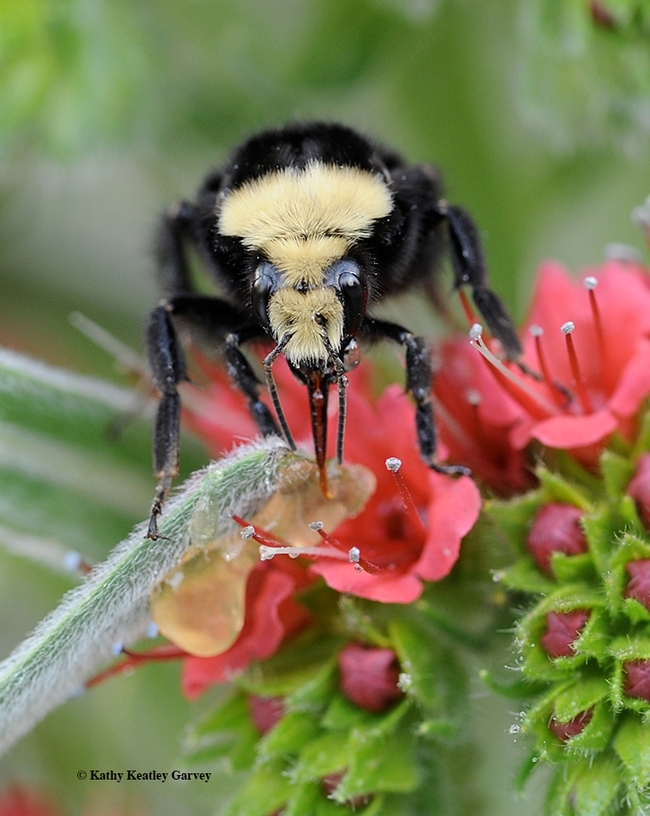
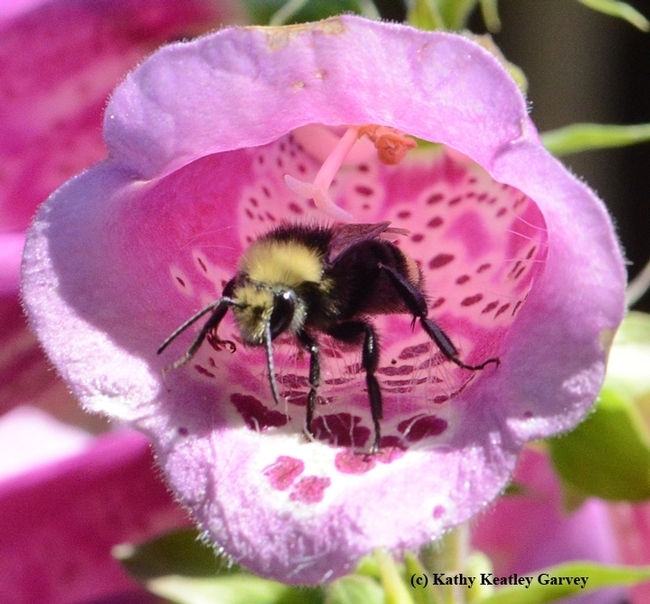
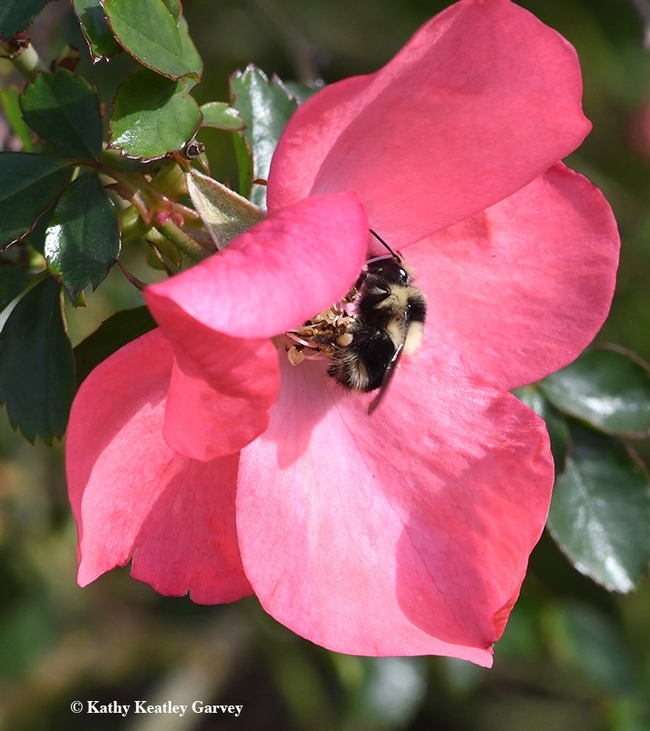
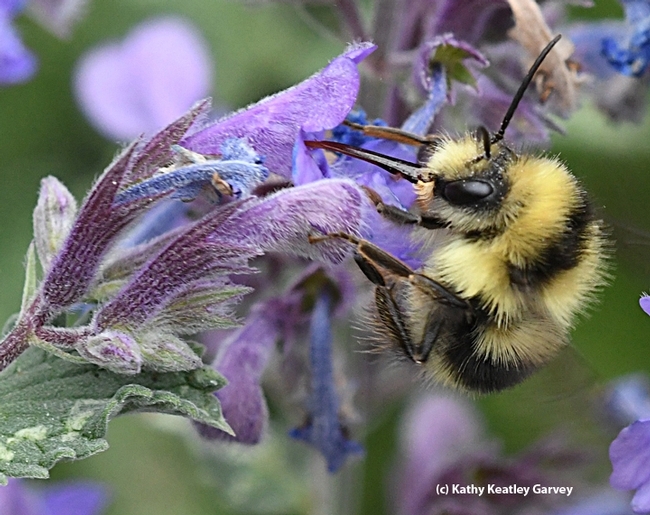
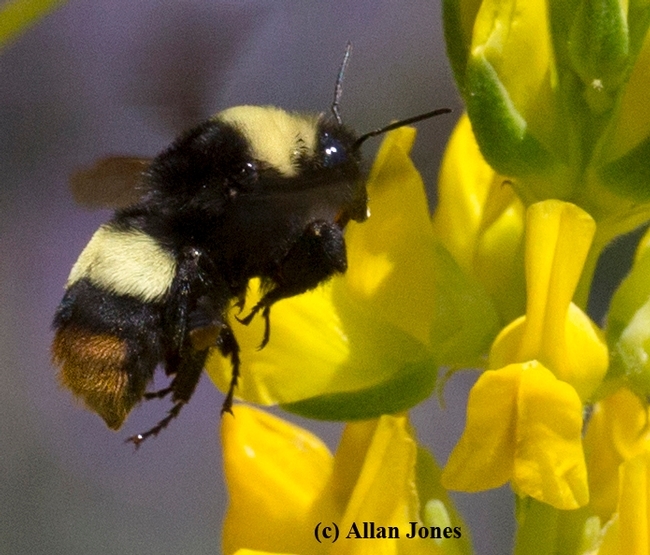
- Author: Kathy Keatley Garvey
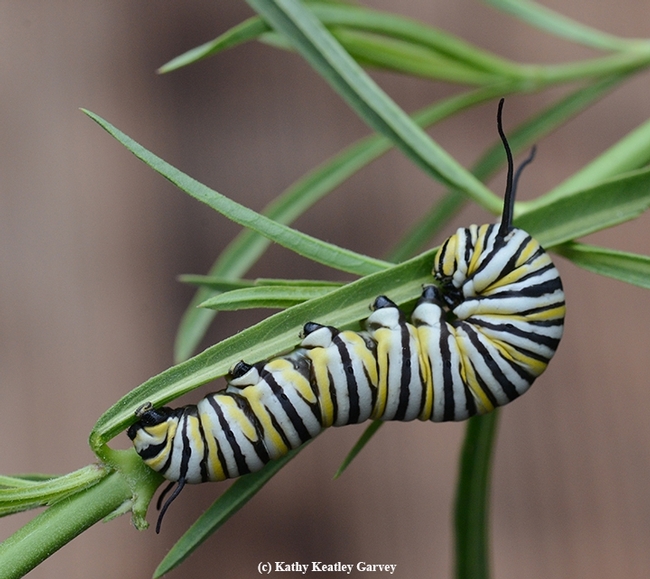
The feral cats on our farm (the progeny of strays dropped off by "imperfect" strangers) became known as "The Look-at-Cats." You couldn't touch, pet or hold them. You could feed them, though, and spay or neuter them--if you could catch them. And you could name them, too. "Look, there's a Look-at-Cat."
Now monarch caterpillars may be the new "Look-at-'Cats."
The troubling decline of monarchs, Danaus plexippus, has led the California Fish and Wildlife to post on its website and issue several mandates:
Conservation Status of Monarch Butterflies
"In 2014, monarchs were petitioned to be listed under the federal Endangered Species Act. In December 2020, the U.S. Fish and Wildlife Service found that listing was warranted but precluded (opens in new tab) by other listing actions on its National Priority List. The monarch is currently slated to be listed in 2024."
"In California, monarchs are included on the California Department of Fish and Wildlife's (CDFW) Terrestrial and Vernal Pool Invertebrates of Conservation Priority list (PDF) (opens in new tab) and identified as a Species of Greatest Conservation Need in California's State Wildlife Action Plan. California law (Fish and Game Section 1002) prohibits the take or possession of wildlife for scientific research, education, or propagation purposes without a valid Scientific Collection Permit (SCP) issued by CDFW. This applies to handling monarchs, removing them from the wild, or otherwise taking them for scientific or propagation purposes, including captive rearing. Due to the current status of the migratory monarch population, CDFW has also issued a mortarium on certain activities covered with an SCP. To learn more about obtaining a collection permit, see our SCP page."
What this means, according to biologist Hillary Sardiñas, senior environmental scientist and pollinator coordinator, Wildlife Diversity Program, California Department of Fish and Wildlife, is no handling or propagating them, including captive rearing, without a scientific collection permit (SCP).
As she wrote in an email today: "Monarch butterflies are a Terrestrial Invertebrate of Conservation Priority which means that handling or propagating them, including captive rearing, without a scientific collection permit (SCP) is not permitted, as described on our monarch website. We have gotten a number of questions on this topic and are currently developing an in-depth FAQ to help people understand threats to monarchs as well as what is and is not permitted. I am happy to share it with you once it is finalized. Unit then, here are answers to your questions:
- Are monarchs in a backyard considered wild? "Wildlife does not only occur on public lands, species can also inhabit private property, including backyards. Therefore, the permit requirement applies to handling activities wherever monarchs occur."
- Educational use? "A scientific collection permit (SCP) is also required for educational purposes. Therefore, the educator would need to have a valid SCP authorizing them to collect/receive and possess monarchs for this purpose. The person collecting the monarch on their behalf would also need a valid SCP or to be named on the educator's SCP. While monarchs have been an incredible tool to learn about long-distance migration and metamorphosis inspiring children and adults for generations, there are so few migratory monarchs that removing just 10 caterpillars could mean you are impacting 5% of the remaining population (estimated at <2,000 in the last overwintering census). At this time, we do not recommend moving caterpillars indoors for any purpose. If educators want to create a monarch garden so that students can observe adult butterflies lay eggs that develop into caterpillars, that scenario would provide an excellent educational opportunity while contributing to monarch conservation."
As Sardiñas, who holds a doctorate from UC Berkeley and formerly worked for the Xerces Society for Invertebrate Conservation, points out: "While monarchs used to be abundant, they are now scarce and the western migratory population has a high estimated likelihood of extinction. A shift from past actions that could cause harm to ones known to be beneficial, such as habitat creation, is required to promote their recovery."
You're encouraged to plant nectar sources and milkweed (the host plant) for the monarchs, but don't touch the eggs, caterpillars, chrysalids or adults. The 'cats, which many teachers traditionally collected to show their students metamorphosis and then released them into the wild--and which monarch moms and dads reared to protect from such predators as birds, wasps, spiders and praying mantids (and parasites)---are now "look-at-'cats."
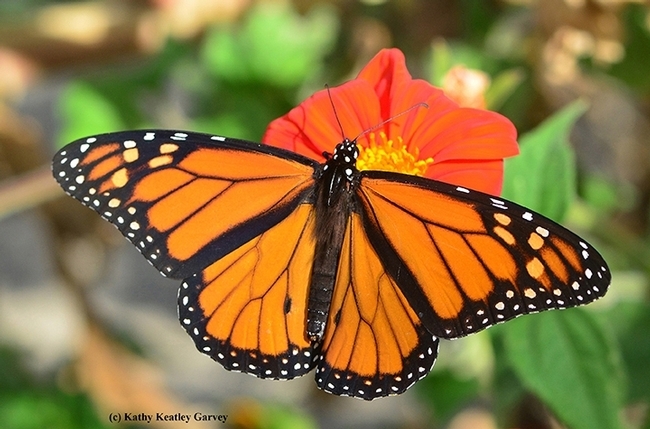
- Author: Kathy Keatley Garvey
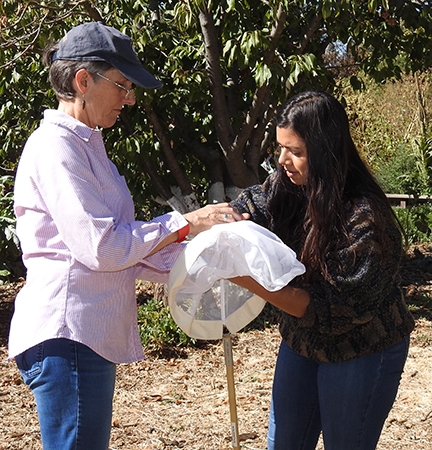
For the contest, Wilson performed a parody of "Billionaire" ("I Wanna Be a Billionaire") by Travie McCoy and Bruno Mars. She humorously titled it "I Wanna Be an Entomologist."
Watch and listen on YouTube.
Now it appears that the work of entomologists collecting insects in California may be in jeopardy...not to mention teachers in grades K-12 and in college.
Lynn Kimsey, director of the Bohart Museum of Entomology and UC Davis professor of entomology, this week proclaimed California's proposed permit rules for insect-collecting as not only “onerous and obtrusive” but will “obstruct the scientific work of researchers and teachers.“
"They amount to a mind-boggling, data-clogging nightmare,” she said.
“This is a major deal for scientific teaching and research,” Kimsey emphasized. “Teachers who assign their students to make insect collections will now have to apply for a permit, and only eight persons are allowed on any one permit. Plus, they have to notify California Fish and Wildlife 48 hours in advance before they collect, and inform them what exactly they will be collecting. It doesn't matter what they're studying—cockroaches, wasps or corn earworms.”
“This will make it even more difficult to study or teach about insects in California,” she said, adding that “Today, California is the only state in the U.S. that requires collecting permits to collect any terrestrial invertebrates, insects, slugs, millipedes, spiders, etc. anywhere in the state, private property, parks, federal lands, cities even, if it's being done for scientific research or teaching in K-12 and college. Ironically, there are no permit requirements for amateur collectors who can collect as much as they want.”
“These requirements,” she said, “will make research and teaching on invertebrates, particularly insects so difficult that it might very well stop our training in entomology and drive researchers to work out of state.”
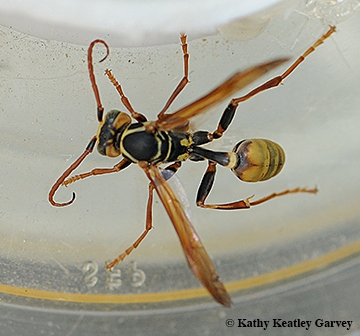
Kimsey, who received her doctorate in entomology at UC Davis, has directed the Bohart Museum of Entomology, since 1990. The seventh largest insect collection in North America, it houses nearly eight million insect specimens (terrestrial and fresh water arthropods) collected globally. The museum is also home of the California Insect Survey, a storehouse of the insect biodiversity of California's deserts, mountains, coast, and the Great Central Valley. Founded in 1946 by its namesake and noted entomologist Richard M. Bohart (1913-2007) of UC Davis, the museum is dedicated to teaching, research and service.
In examining the proposed new rules for collecting insects, Kimsey cited seven crucial issues:
1. New Species. There may be as many as 100,000 species of terrestrial invertebrates in California and perhaps 6 percent are new to science. “This is far more species than we have the expertise in-state to identify,” she pointed out. “Sometimes it takes decades for someone to study a particular group. So it's impossible to give CDFW identifications much more detailed than Insecta for the permit paperwork.”
2. All Insects. These permit requirements apply whether “you're surveying the insects of a vernal pool or the distribution of dangerous invasive species, such as the yellow fever mosquito,” Kimsey said. “They also apply to the study of pest species, such as cockroaches and bedbugs.”
3. Bureaucracy. The required fees and detailed reports are onerous, obtrusive and seem to punish researchers and students studying and learning about insects, Kimsey declared. Permits take 6-8 weeks to be awarded and every time a change is needed, an emendation fee applies. “At UC Davis we are on the quarter system, which is 10 weeks. This means that a permit would be awarded by the time a class requiring students to make a collection is nearly over.”
4. Identification. “When we collect insects,” Kimsey explained, “we generally do not know what we've found until the material has been sorted, curated and identified to major group under the microscope--the vast majority of insects cannot be sight-identified and most are less than 1/4 inch long. This could take weeks and months. Specimens then need to be examined by experts who could be anywhere in the world.”
5. Chain of Custody. Every time the Bohart Museum of Entomology, home of nearly eight million insect specimens, ships specimens collected in California to an expert, “we would have to do CDFW chain-of-custody paperwork,” Kimsey said. “We take in an average of 30,000 specimens a year from university researchers and students. We loan up to 1,000 specimens a year to experts around the world. The paperwork would be crushing.”
6. Non-Target Insects. CDFW also requires permitees to account for by-catch, that is, non-target insects. “It's not clear if this includes insects collected on the radiator while driving in the study site,” she said.
7. Crime Scenes. Permits would also be required for the study of insects at crime scenes and any training that pertains to forensic entomology.
Kimsey said the simplest solution to this issue is “to simply remove terrestrial invertebrates from the permit requirements. But after the recent public meeting, that seems unlikely to happen.”
“We cannot see any benefit to the state in requiring permits for invertebrates when the information gained would be close to useless,” Kimsey declared. “California Wildlife and Wildlife informed us that the permit fees were necessary to cover the costs of dealing with the specimen data, but the data will not be useful and it would make much more sense to simply not cover terrestrial invertebrates.”
The entire data collection/permit process would result in a mind-boggling, data-clogging nightmare, she said. “If everyone in the state working on insects and teaching about them sent the specimen data to CDFW, they might be dealing with hundreds of thousands of data entries and thousands of reports annually, most of which would provide very little data. This amounts to an unfunded mandate, which will cost museums, scientists and teachers time and money. Museums would literally have to hire additional personnel to do the paperwork.”
Unfortunately, not many people were aware of the May 8 public hearing, but comments are continuing, although the department requested comments by 5 p.m., May 8, 2017, as outlined in the notice.
Contact information:
California Department of Fish and Wildlife
Regulations Unit - Scientific Collecting Permits
Attn: Ona Alminas, Environmental Scientist
1416 Ninth Street, Room 1342-A
Sacramento, CA 95814
Phone: 916-651-9167
Email: SCPermits@wildlife.ca.gov
Meanwhile, entomologists and other insect enthusiasts are weighing in this troubling issue on social media.
The comments include:
- "If California's bizarre new insect collecting regulations go through, it will effectively end entomology in that state."
- "This is absolutely horrific and pointless, I also wonder what the motivation is, who came up with this??"
- "Ironically, there are no permit requirements for amateur collectors who can collect as much as they want."
- "Will there be a special hot line? Hello? I would like to collect a cockroach this weekend. Ok you will need Form Pa111: permission to pick up and hold a cockroach; and Form Pa222: permission to detain a cockroach against its will!"
- "I love the fact that the permits are required only for scientific, educational, and non-commercial propagation purposes. So, if I wanted to collect butterflies to mount and sell, I could take as many as I wanted, no permit, notice, or paperwork required. But if I wanted to tag migratory butterflies and release them, I have to get a permit, give 48 hours notice, and maintain onerous amounts of paperwork."
- "I'm not a scientist and am only collecting these beautiful rare butterflies to feed to my frogs. No permit necessary." (said in jest)
- "We had to fill out more paperwork to collect and photograph common insects in Washington State National Forests than we did to study endangered invertebrates or endangered vertebrates!"
- "PA (Pennsylvania) was this way- for aquatic ecology we took a class field trip to get fishing permits to collect 'bait.'
